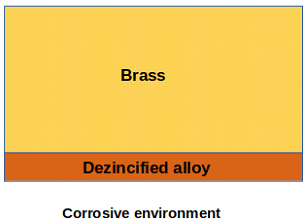This set of Corrosion Engineering Multiple Choice Questions & Answers (MCQs) focuses on “Eight Forms – Selective Leaching”.
1. Selective Leaching is the removal of one element from a solid alloy by the corrosion process.
a) True
b) False
View Answer
Explanation: Selective leaching is one of the types of corrosion that results in the removal of one element from a solid alloy by the corrosion process. Dezincification, dealuminumification, and decobaltification are examples of selective leaching.
2. What is the percent of zinc that consists of common yellow brass?
a) 70%
b) 30%
c) 40%
d) 60%
View Answer
Explanation: The composition of common yellow brass is approximately 30% zinc and 70% copper. Dezincification alloy assumes a red or copper color that contracts to the original yellow color.
3. Which of the following is/are the types of dezincification?
a) Layer-type
b) Plug-type
c) Layer-type and Plug-type
d) Neither Layer-type nor Plug-type
View Answer
Explanation: There are two common types of dezincification types. They are
i. Layer-type or uniform
ii. Plug-type or localized
4. The Alloying of zinc to copper lowers the corrosion resistance of the copper.
a) True
b) False
View Answer
Explanation: Alloying of zinc to copper lowers the corrosion resistance of the copper. The oxide film of copper is highly dense, stable, and has a high resistance to corrosion. Whereas zinc-copper alloy has a relatively less stable oxide film.
5. Which of the following is/are the characteristics of dezincified brass alloy?
a) Weak
b) Permeable
c) Porous
d) Weak, permeable and porous
View Answer
Explanation: Dezincified brass alloy is an alloy in which the zinc is removed in a particular corrosive solution by selective leaching. Weak, permeable, and porous are the characteristics of dezincified brass alloy.
6. Which of the following type of brasses is/are highly prone to the uniform or layer-type dezincification?
a) Low brasses
b) High brasses
c) Low and high brasses
d) Neither high nor low brasses
View Answer
Explanation: The composition of high brasses is usually 65% copper and 35% zinc. High brasses are highly prone to the uniform or layer-type dezincification in acidic environments.
7. Which of the following type of brasses is/are highly prone to localize or plug-type dezincification?
a) Low brasses
b) High brasses
c) Low and high brasses
d) Neither low nor high brasses
View Answer
Explanation: The composition of low brasses are usually 80% copper and 20% zinc. Low brasses are highly prone to localize or plug-type dezincification in alkaline, neutral, and slightly acidic environments.
8. Which of the following is/are the preventions of dezincification?
a) Minimizing oxygen concentration
b) Use of less susceptible alloy
c) Adding a small amount of arsenic, antimony
d) Removal of oxygen concentration, use of less susceptible alloy and adding a small amount of arsenic, antimony
View Answer
Explanation: Dezincification can be minimized or reduced by
i. Minimizing the oxygen concentration in the environment
ii. Use of less susceptible alloy such as red brass (15% zinc)
iii. Adding small amounts of arsenic, antimony, and phosphorus as an inhibitor
9. Which of the following phenomenon that results in the dissolution of iron by leaving porous graphite on the surface of grey cast iron?
a) Dezincification
b) Decalcification
c) Graphitization
d) Dezincification and graphitization
View Answer
Explanation: Graphite is cathodic to iron in grey cast iron that results in the dissolution of iron by leaving porous graphite in a mild corrosive solution. This phenomenon is known as graphitization.
10. Which of the following type of cast irons that exhibits graphitization?
a) Grey cast iron
b) Nodular cast iron
c) Malleable cast iron
d) Grey cast iron, nodular cast iron, and malleable cast iron
View Answer
Explanation: Graphitization occurs only in grey cast iron whereas it doesn’t occur in nodular, malleable, and white cast iron as the graphite network is not present to hold together at the surface.
11. Which of the following acid that results in selective removal of aluminum in aluminum bronzes?
a) Hydrochloric acid (HCl)
b) Hydrofluoric acid (HF)
c) Nitric acid (HNO3)
d) Hydrochloric, hydrofluoric and nitric acid
View Answer
Explanation: Selective Leaching is the removal of one element from a solid alloy by the corrosion process. And selective removal of aluminum from aluminum bronzes can be resulted by using hydrofluoric acid.
12. Which of the following is/are the other names of selective leaching?
a) Dealloying
b) Parting
c) Dealloying and parting
d) Neither dealloying nor parting
View Answer
Explanation: Selective Leaching is the removal of one element from a solid alloy by the corrosion process. The other names of selective leaching are dealloying and parting.
13. Which of the following is/are the benefits of selective leaching?
a) Enrichment of silicon on stainless steel for better passivity
b) Preparation of Raney nickel catalyst
c) Extraction of metals using hydrometallurgy
d) Enrichment of silicon on stainless steel for better passivity, preparation of Raney nickel catalyst and extraction of metals using hydrometallurgy
View Answer
Explanation: The benefits associated with selective leaching are
i. Enrichment of silicon on Stainless steel for better passivity
ii. Preparation of Raney nickel catalyst
iii. Extraction of metals using hydrometallurgy
14. Which of the following type of corrosion is depicted in the given figure?

a) Galvanic corrosion
b) Uniform corrosion
c) Selective leaching
d) Erosion corrosion
View Answer
Explanation: Selective Leaching is the removal of one element from a solid alloy by the corrosion process. And in selective leaching, it is a layer or uniform type of zincification. It highly occurs in high brasses that contain 35% zinc approximately.
Sanfoundry Global Education & Learning Series – Corrosion Engineering.
To practice all areas of Corrosion Engineering, here is complete set of 1000+ Multiple Choice Questions and Answers.
If you find a mistake in question / option / answer, kindly take a screenshot and email to [email protected]
- Practice Mechanical Engineering MCQs
- Check Corrosion Engineering Books
- Check Mechanical Engineering Books
- Practice Metallurgical Engineering MCQs
- Apply for Mechanical Engineering Internship
